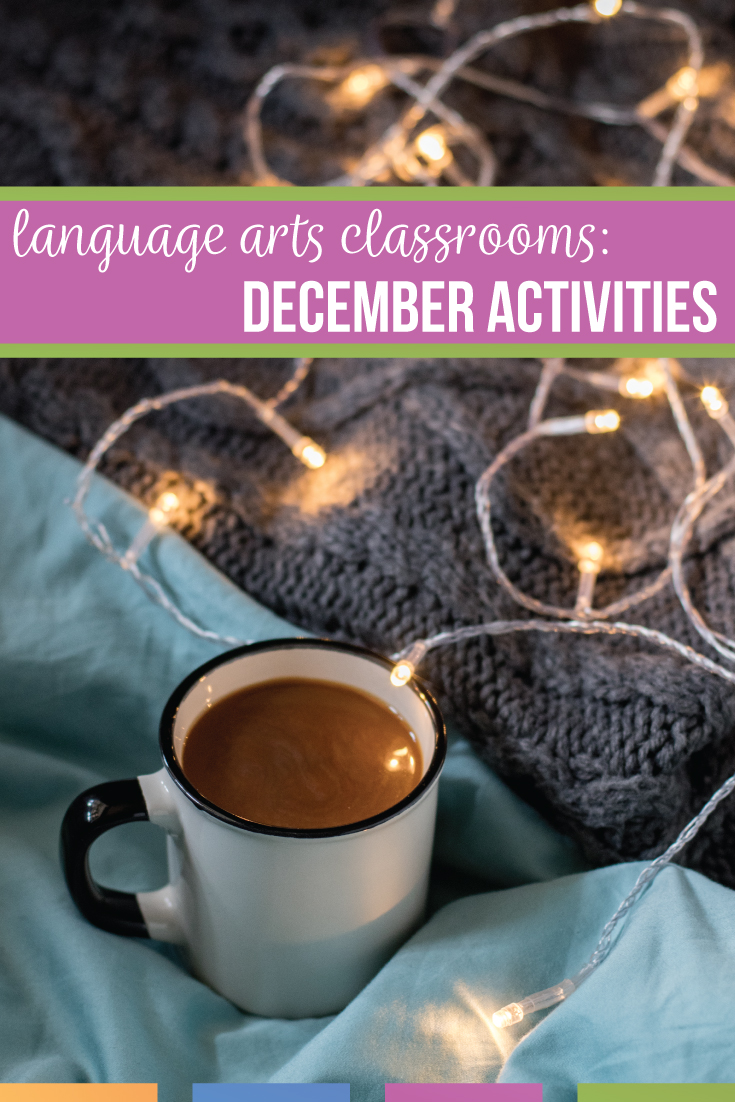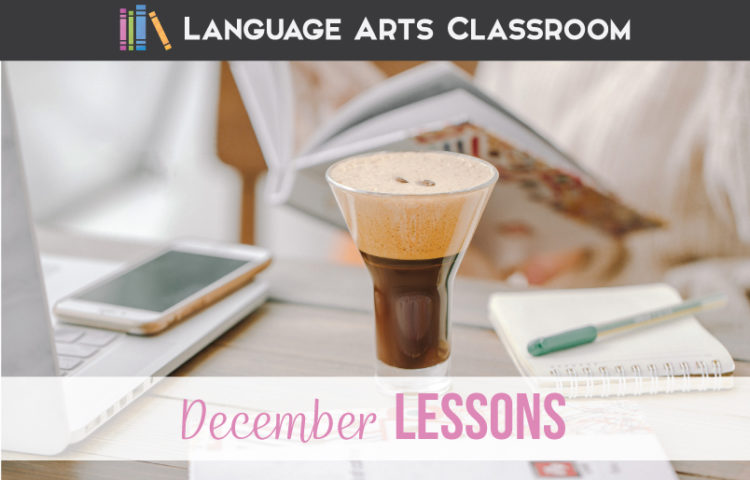December lesson plans for secondary language arts: read on to learn how I manage the stress and excitement of the upcoming winter break.
I possess a single way to contribute to student and teacher happiness as winter break approaches:
Maintain standards and procedures.
Fancy? Nope. I’ll wave my arm around, happily admitting that is a dull and ordinary suggestion.
Chaos and excitement will engulf students as winter break approaches. Their town and houses are decorated. Food and toy drives abound. Students might be busy with their churches or other nonprofits. Plus, secondary students often take finals before winter break dismissal. They are overwhelmed.
You can be the calming presence for them. Continue with the procedures you established early in the school year. You and your students will be happy from that.
Still! I do acknowledge the holiday season with language arts winter activities. We still meet standards, stick to our routines, and still progress. You can easily add language arts December activities with a bit of magic.
Here are ten December lesson plans that will provide structure and get everyone through the busy winter season.

Write about the holidays.
My students stress about finals and their grades. They are tired (I’m tired too), and we are all busy. Don’t ignore the holidays—you can’t! Power those thoughts into a writing assignment.
Provide students with writing options because many have conflicting feelings and experiences surrounding the holidays. Take that into consideration: not every student has family events that students will happily share. I use this narrative writing activity because it allows students to choose their writing topic. Students can write about anything winter-related!
Review writing and language standards with targeted language arts December activities such as writing.
Switch-up review.
My students take finals before they leave for winter break. I set them up for success with review opportunities. To relax, we color while reviewing grammar. Students often need to review grammar before their finals, and those sheets can encourage differentiation. Not every student will need to complete every sheet.
Give a small gift.
I don’t always see students again after final exams! We switch classes when we return in January, and this may be the last time I see those students that I’ve had since August.
Bookmarks are my favorite gift for students because they send a positive message about reading. These are free, and you can attach them to an inexpensive gift, like a candy cane or small container of modeling clay.
Personalize First Chapter Friday.
You can easily turn First Chapter Friday into a seasonal read-aloud. Many books that take place in winter would be perfect for reading to secondary students: The Lion, The Witch, and The Wardrobe; The Call of the Wild; and Brian’s Winter.
You could also re-read portions of the first Harry Potter. Tons of picture books address winter, and they can easily be added as they are short reads.
Get students moving.
Students are tired as they near the end of the first semester. I get students moving with task cards and station work. Sometimes, students spend lots of time alone studying during the semester. As they get restless, I provide opportunities for movement.
Review for finals.
When I write final exams, I try to plan with a variety of review tools. I use Kahoot, GimKit, and Study Stack. Students appreciate the variety, and I take the opportunity to model studying skills with them.
Sometimes, I model how to study with overwhelming amounts of information. I discuss what works for me, what works for others, and where to scale back. For instance, I do well making flash cards to study. However, I don’t have time to write every note that I’ve taken throughout a semester into a note card. I model my methods to help students review for finals.
Connect lessons to class parties.
Often, teachers host an end-of-the-semester party. Why not study the food that students bring? This language one-pager asks students to study the marketing and messaging food companies use to sell their products. Before students dive in, encourage them to notice the marketing that perhaps encouraged them to buy the food.
Add creative writing.
Creative writing might get pushed to the edge of a curriculum, but some students adore creative activities. You can meet standards while providing a low-stress opportunity for students to showcase their writing skills. Try building a character or writing a dystopian setting. A little bit of freedom with creative writing might be the chance some students need to connect with your class.
Often, you can find an authentic audience for your students during the winter months. Is a local nonprofit needing help with brochures or flyers? What about advertisements for local events? Students can write creatively for an authentic audience and help their communities.
Show a movie with purpose.
I’m in Illinois, and sometimes we have snowy days where not all of my students come to school. Other days, I’ll have a large portion of students out sick. In many situations, I’ll show students a movie or documentary that allows for deeper discussion. I never want students to “goof off” for a day, so I purposefully structure an activity with flexibility.
Part of organizing language arts December activities is scheduling flexibility.
Provide student choice.
As you review writing lessons, let students choose their writing topics. (You can download those for free.) Students appreciate the gesture from you, and you won’t be reading the same paper fifty times!
Secondary students might display a variety of emotions as winter break approach. The holidays can be fun, scary, overwhelming… lots of emotions! With structure and few well-placed language arts winter activities, you can meet standards while acknowledging student excitement.
Some of my students are working extra hours, as many high schoolers work retail. Some are excited for the holidays, and others may face contentious family situations. With secondary students, we teachers must remember that these students arrive with a variety of emotions for the holidays. Acknowledge the holiday season but provide that comforting and familiar structure your classroom offers. December lesson plans can acknowledge winter fun while not overwhelming students.
Not quite ready for December language arts ideas? Try November English lessons. Planning ahead? Try January English lessons.


